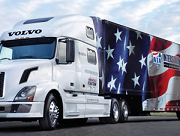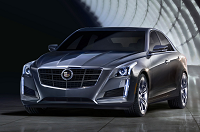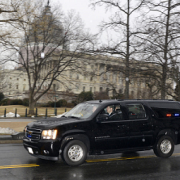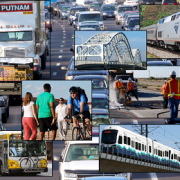U of M Celebrates Grand Opening of ‘M City’ Testing Ground; 2015 AVS Shows Signs That Debut of Advanced Technologies Could Be Imminent
John Estrada
This week was a big one for the world of automated vehicles, particularly in Michigan. First, the University of Michigan’s Transportation Research Institute, or UMTRI, celebrated the grand opening of its M City test facility.
An intersection in M City, a small city created to be a testing ground for driverless and connected vehicles in Michigan.
The facility is designed for the testing of automated and connected vehicles in a controlled environment. It has a wide range of road types, from freeway exits to city streets to roundabouts (traffic circles). Additionally it has realistic signage and other roadway features. The stop sign even has graffiti on it!
This was a major event on Monday, with the governor of Michigan, both of the state’s U.S. senators and numerous industry VIPs all in attendance.
A ‘downtown’ area for driverless and connected test cars to maneuver through in M City, a small city created to be a testing ground in Michigan.
Additionally this week, Michigan hosted the 2015 Automated Vehicle Symposium (AVS). This is the fourth year for this show, and the second in which it has been co-hosted by TRB and AUVSI. Jane Lappin from the DOT Volpe Research Center in Massachusetts, who is one of the main organizers of the show, noted early on that it was getting harder to get speakers for the show, even though the industry is clearly growing, which hopefully is an indication that announcements and rollouts of new technologies must be just over the horizon. That definitely seemed to be the case, as most of the main speakers really didn’t present anything new.[1]
An autonomous vehicle prototype on display at the 2015 AVS symposium in Ann Arbor, Mich. in July 2015.
One exception to this was the presentation by Dr. Mark Rosekind of NHTSA. Dr. Rosekind was the initial keynote speaker at the opening session. He noted that today, “motorists have had to accept that loss of life is part of the cost of mobility.” He discussed how the DOT is accelerating its effort to change this model, in particular with the moving up of the timetable for the requirements on DSRC safety requirements.
He also discussed how the government was increasing its focus on cybersecurity. This was very timely given the article this week in Wired Magazine about the hacking of a Jeep Cherokee while it was driving on a St. Louis freeway. As we move control of vehicles from drivers to connected technology built by engineers and programmers, this will only take on a much greater requirement.
This was the biggest show in the series to date, and we expect an even bigger show next year.
[1] We were asked not to present any information on the breakout sessions. These did contain some more interesting details.





